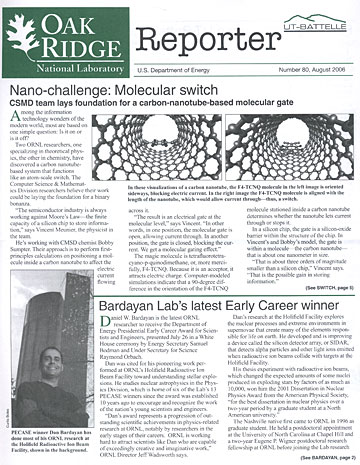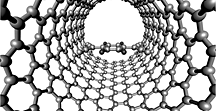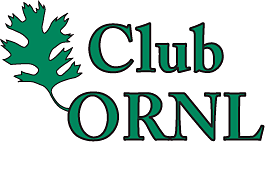 |
Number 80, August 2006 |
 Nano-challenge: Molecular switch
Nano-challenge: Molecular switch
CSMD team lays foundation for a carbon-nanotube-based molecular gate
|
|
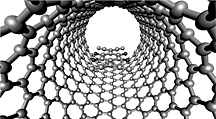 |
| In these visualizations of a carbon nanotube, the F4-TCNQ molecule in the left image is oriented sideways, blocking electric current. In the right image the F4-TCNQ molecule is aligned with the length of the nanotube, which would allow current through—thus, a switch. | |
Among the information
technology wonders of the modern world, most are based on one simple question: Is it on or is it off?
Two ORNL researchers, one specializing in theoretical physics, the other in chemistry, have discovered a carbon nanotube-based system that functions like an atom-scale switch. The Computer Science & Mathematics Division researchers believe their work could be laying the foundation for a binary bonanza.
“The semiconductor industry is always working against Moore’s Law—the finite capacity of a silicon chip to store information,” says Vincent Meunier, the physicist in the team.
He’s working with CMSD chemist Bobby Sumpter. Their approach is to perform first-principles calculations on positioning a molecule inside a carbon nanotube to affect the electric current flowing across it.
“The result is an electrical gate at the molecular level,” says Vincent. “In other words, in one position, the molecular gate is open, allowing current through. In another position, the gate is closed, blocking the current. We get a molecular gating effect.”
The magic molecule is tetrafluorotetracyano-p-quinodimethane, or, more mercifully, F4-TCNQ. Because it is an acceptor, it attracts electric charge. Computer-modeled simulations indicate that a 90-degree difference in the orientation of the F4-TCNQ molecule stationed inside a carbon nanotube determines whether the nanotube lets current through or stops it.
In a silicon chip, the gate is a silicon-oxide barrier within the structure of the chip. In Vincent’s and Bobby’s model, the gate is within a molecule—the carbon nanotube—that is about one nanometer in size.
“That is about three orders of magnitude smaller than a silicon chip,” Vincent says. “That is the possible gain in storing
information.”
One of the greatest challenges in this basic research is to develop a robust approach to modifying the state of the F4-TCNQ molecule between the on and off possibilities. The flipping mechanism would enable the researchers to rotate the molecule to either a lengthways (on) or sideways (off) position on demand, thereby creating the ultimate nonvolatile memory element working at room temperature.
“There are not many possible ways to move a molecule that is embedded into a nanowire. Here, the trick is to exploit not the properties of the molecule but rather make use of those of the nanowire,” Vincent says.
In the “on” position, their models have shown that the carbon nanotubes would allow current to pass through them.
In the “off” orientation, the current is reflected back, blocking the current.
Bobby recently completed calculations where small external mechanical strains applied to the external surface of nanowire readily led to the reproducible rotation of the F4-TCNQ molecule, indicating that the gate would be stable and also retain information in a room temperature environment.
The models require enormous computational power, available to the researchers onsite through the National Center for Computational Sciences.
“These are very big calculations using state of the art quantum chemistry methods,” says Bobby. “That’s the only way we can get it to work.”
The two researchers, who split their time between CSMD and the Center for Nanophase Materials Sciences, are enjoying a very successful partnership that incorporates its own interdisciplinary chemistry. Vincent, who is primarily a theoretical physicist, does the physics-based calculations on the concept. Bobby, who is a physical chemist, then applies his practical knowledge of chemistry to the problem.
“We work together,” Vincent says. “I wrote the code in transport and Bobby did the physical chemistry. That’s one of the strengths of our Computational Chemical Sciences group. It cuts across several areas of research that allows us to apply different approaches to novel ideas. However, it is really the computational infrastructure that allows us to test our ideas.” —B.C. ![]()
 Bardayan Lab’s latest Early Career winner
Bardayan Lab’s latest Early Career winner
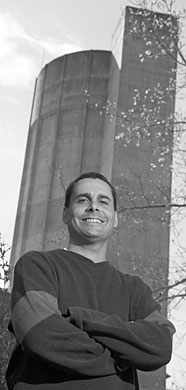 |
PECASE winner Dan Bardayan has done most of his ORNL research at the Holifield Radioactive Ion Beam Facility, shown in the background. |
Daniel W. Bardayan is the latest ORNL
researcher to receive the Department of Energy Presidential Early Career Award for Scientists and Engineers, presented July 26 in a White House ceremony by Energy Secretary Samuel Bodman and Under Secretary for Science
Raymond Orbach.
Dan was cited for his pioneering work performed at ORNL’s Holifield Radioactive Ion Beam Facility toward understanding stellar explosions. He studies nuclear astrophysics in the Physics Division, which is home of six of the Lab’s 13 PECASE winners since the award was established 10 years ago to encourage and recognize the work of the nation’s young scientists and engineers.
“Dan’s award represents a progression of outstanding scientific achievements in physics-related research at ORNL, notably by researchers in the early stages of their careers. ORNL is working hard to attract scientists like Dan who are capable of exceedingly creative and imaginative work,” ORNL Director Jeff Wadsworth says.
Dan’s research at the Holifield Facility explores the nuclear processes and extreme environments in supernovae that create many of the elements responsible for life on earth. He developed and is improving a device called the silicon detector array, or SIDAR, that detects alpha particles and other light ions emitted when radioactive ion beams collide with targets at the Holifield Facility.
His thesis experiment with radioactive ion beams, which changed the expected amounts of some nuclei produced in exploding stars by factors of as much as 10,000, won him the 2001 Dissertation in Nuclear Physics Award from the American Physical Society, “for the best dissertation in nuclear physics over a two-year period by a graduate student at a North American university.”
The Nashville native first came to ORNL in 1996 as graduate student. He held a postdoctoral appointment at the University of North Carolina at Chapel Hill and a two-year Eugene P. Wigner postdoctoral research fellowship at ORNL before joining the Lab research staff in 2003. He received his master’s and doctorate degrees from Yale University and did his undergraduate work at Tennessee Technological University in Cookeville.
Dan, his wife, Melissa, and sons, Mac and Grant, live in Farragut.—B.C. ![]()
 Forsberg, Rao named UT-Battelle corporate fellows
Forsberg, Rao named UT-Battelle corporate fellows
The Nuclear S&T Division’s Charles Forsberg and the Computer Science & Mathematics Division’s Nageswara Rao are ORNL’s newest UT-Battelle corporate fellows, a designation reserved for the highest level of recognition for career achievements in science and technology, performance and leadership.
“ORNL aspires to the highest standard of scientific achievement,” says ORNL Director Jeff Wadsworth. “Becoming a corporate fellow is recognition that these two researchers have met that standard.”
 |
Forsberg |
Charles Forsberg began his career at ORNL in 1975 in the Chemical Technology Division after earning a doctorate in nuclear engineering from Massachusetts Institute of Technology and two years of industry experience at Bechtel. He led research activities that successfully separated actinide and rare earth elements from acidic high-level waste solutions and provided leadership on nuclear waste management issues.
Charles developed and patented the Process Inherent, Ultimate-Safety Boiling Water Reactor. Fluidic accumulators that evolved from this patent are now part of advanced light-water reactor designs. As a result of his leadership in light-water reactor development, he was appointed U.S. technical representative to the International Atomic Energy Agency Working Group on Advanced LWR Technologies.
In 1995, Charles shifted his focus back to nuclear waste issues, developing and patenting approaches to depleted uranium waste disposition and leading the team that developed disposition options for uranium-233. He proposed separating short-lived strontium and cesium isotopes from spent nuclear fuel to significantly reduce heat loads in repository designs, a concept that is being intensively investigated by DOE to increase repository capacity.
Charles has been an adviser to the Nuclear Regulatory Commission, National Academy of Sciences and DOE on numerous issues related to nuclear technology and the hydrogen economy. He is a fellow of the American Nuclear Society and recipient of the 2005 Robert E. Wilson Award of the American Institute of Chemical Engineers and 2002 American Nuclear Society Special Award for Innovative Nuclear Reactors. He has published more than 250 scientific papers and reports and been granted 10 patents.
Charles and his wife, Virginia, live in Oak Ridge. The couple’s two children, Christopher and Martin, live in Seattle.
 |
Rao |
Nageswara Rao received his doctorate in computer science from Louisiana State University in 1988 and completed his doctoral work at ORNL at the Center for Engineering Science Advanced Research in the Computer Science and Mathematics Division. Before joining ORNL in 1993 Nageswara served on the faculty of Old Dominion University.
Nageswara is nationally recognized for his pioneering contributions in the fields of high-performance networking and multiple-sensor fusion. He has answered several fundamental questions related to the design of high-throughput network transport protocols, proving the chaotic nature of the widely deployed transmission control protocol and initiating the design of protocols that have proven stable and effective. He is also credited with developing a unifying theory of information fusion, solving a long-standing fundamental question critical to his field.
In the area of high-performance computing, Nageswara has established ORNL as a national leader, winning significant funding from the National Science Foundation, the Defense Advanced Research Projects Agency, the Office of Naval Research and DOE. His DOE UltraScience Net and NSF Cheetah projects hold enormous promise in meeting the high bandwidth and control demands of large-scale science applications, demonstrating leadership in developing mathematical methods that underpin and provide needed solutions to practical networking problems.
Nageswara received the 2005 Technical Achievement Award from the Computer Society of the Institute of Electrical and Electronics Engineers for his work on information fusion methods over the last decade. He has published more than 200 technical papers, was instrumental in founding two international journals and serves on boards for five journals. He has co-chaired five conferences and served on more than 25 international conference committees.
Nageswara and his wife, Nina Rivers Hathaway, live in Powell.—Ron Walli ![]()
 ORNL People
ORNL People
The July 2006 edition of the Journal of The American Society for Mass Spectrometry features the Chemical Sciences Division’s Gary Van Berkel, the 2005 recipient of the society’s prestigious Biemann Medal. The issue includes eight papers from present and former ORNL colleagues.
Rongying Jin of the Materials S&T Division is being recognized as a “rising star” by Women of Color Magazine and the IBM Corporation. The notation recognizes young minority women who have excelled in technical fields and demonstrated exceptional achievement in their workplaces and communities in the early stages of their careers.
Three Lab staff members will be honored as UT-Battelle Corporate Honorees at the upcoming 2006 Oak Ridge YWCA Night of Tribute program. Ho-Ling Hwang, Joanne Oxendine Ramey and Melissa C. Smith were nominated in the health, science and technology category. The annual YWCA Night of Tribute ceremony is set for August 16 at the Oak Ridge Mall’s Crown Court. ![]()
 |
 Prevent pollution, fertilize the earth
Prevent pollution, fertilize the earth
ORNL received a Pollution Prevention Best-In-Class award from DOE in July. This year’s award makes the third consecutive year that the Lab has won or shared a P2 award, which cites areas in which ORNL has excelled in environmentally conscious management practices.
Most of the awards are based on initiatives and practices that are, by now, pretty familiar to Lab staff members, such as legacy materials reduction efforts, building construction to LEEDS environmental standards and the Green Transportation Initiative, which includes the carpool program and last year’s establishment of a bike-friendly lane on Bethel Valley Road.
More out of the ordinary was the recycling of scrap wallboard from the Multipurpose Research Facility construction project on the east campus. The gypsum board remnants, which accumulated for weeks in a pile on the construction site, turn out to be a pretty good fertilizer.
 |
Instead of filling up a landfill, scrap wallboard from an ORNL construction project will be fertilizing Fred Nelson’s hayfield. |
So good, in fact, that a heavy equipment operator on the project, Fred Nelson, who owns a tract of property near Rockwood, took all of the ground-up sheetrock to apply to a hayfield.
Heery International, the contractor, working with the University of Tennessee’s Center for Industrial Services and Waste Connections, had about 80 tons of the stuff and was glad to put it where it could do some good, says Heery’s Glenn Bellamy.
“Gypsum has calcium sulfate. The calcium help balance the soil’s pH and the sulfur is needed by some plants, like sweet potatoes, to grow,” Glenn says. “It’s generally a good soil conditioner.”
Glenn says Heery intends to continue recycling as much leftover construction material as it can, which includes grinding scrap wood into mulch and reusing ferrous metals and concrete, which takes pressure off landfills.
 SMAC lives on in Alabama
SMAC lives on in Alabama
Actually, wall board wasn’t the only thing the Lab put to good use and kept out of the landfills. Accelerators from ORNL’s former Surface Modification and Characterization research center, which was located on the hilltop near the Quonset huts, have found new life after the ORNL programs ended.
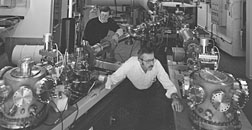 |
SMAC in 1985, with Jim Williams (front) and Steve Withrow |
The SMAC facility was where much of ORNL’s ion-implantation research occurred, including the renowned artificial hip-joint programs. (The implanted ions make the joint surfaces more durable.)
One of SMAC’s accelerators went to Alabama A&M University. A&M faculty members used the SMAC facility often at ORNL and will continue the research at the university.
“The move made a lot of sense,” says the Materials S&T Division’s John Cooke. “We saved the capability—we can still have access to it—and it didn’t just go to waste.”
The former Condensed Matter Sciences Division’s recycling efforts were credited in the P2 award for 150 tons of equipment being recycled, reused or sold—saving landfill space—and an estimated cost avoidance of more than $3 million.
 Leave the lawn chairs at home
Leave the lawn chairs at home
 |
Shibata |
How’s your summer? Jason Shibata recently ran, swam, biked, navigated and climbed 400 miles through the Utah desert in an eight-day-long adventure race. Jason is an Air Force captain who just completed a 10-month stint in the National Security Directorate as part of the Air Force Education with Industry program.
The race, called Primal Quest, took place in the isolated Moab Desert from June 25 through July 3. Jason’s four-man team, on two hours’ sleep per night, managed to average over 50 miles per day despite oppressive heat, varied and demanding events and elevations ranging from 3,993 to 10,539 feet.
A 22-hour workday is ideal for accomplishing so much—at least for about two days. Then, the body begins to do what Jason calls “sleep bonking”, falling asleep in mid-stride or stroke or pedal.
Jason’s team tried to combat sleeplessness by scheduling their two-hour power naps at two in the morning. They would wake just before dawn and use the sun as a physiological alarm clock.
Of the 89 teams that began, only 28 finished, a 69-percent attrition rate in a race that costs $8,000 to enter. Jason’s team finished 17th.
Adventure racing differs from races like triathlons because it requires navigation and multiple-day racing.
Primal Quest mostly involved navigating on bike and foot through remote canyons in temperatures over 100 degrees while carrying enough food, water and gear to last 40 hours. The elevation change was so great that on the higher sections they found—and ate—snow.
—Reported by Bill Cabage and Charlie Smith |
 Go ask ALICE
Go ask ALICE
CERN experience was key for Silvermyr; he’s going back for collider experiment
CAs an undergrad at Luden University,
David Silvermyr had to make a critical decision: Should he study complex systems or particle physics? The Swede credits his first experience at CERN, the world’s largest particle physics center, in 1997 with guiding his choice.
As a summer student, David experienced the experimental world of quarks and gluons. He watched as colliding particles created more and more particles. That pushed him to pursue high energy ion physics.
“It’s the idea of making something from nothing, following Einstein’s E=mc2,” the ORNL heavy ion particle physicist says. “You have two gold molecules, each with say 200 particles, and you create something like 5,000 particles when they collide.”
A thousand scientists are joining together to create and run the ALICE experiment, which will weigh more than the Eiffel Tower. |
|---|
David will be returning to the European particle physics lab after nine years away, but this time he will be a major collaborator on one of CERN’s newest experiments, ALICE. A Large Ion Collider Experiment will be the most modern “eyes” that will examine the sub-atomic world of quarks and gluons.
David is one of 1,000 scientists joining together to create and run this experiment, which will weigh more than the Eiffel Tower, he says. The 7,000-ton structure will hold one of 13 detectors that can peer into quark-gluon plasma, which is ultimately what scientists using ALICE want to study. Working with five other Oak Ridge scientists and 45 scientists from universities and labs around the country, David and his colleagues will set up the EMCal, or ElectroMagnetic Calorimeter, detector inside ALICE.
David has been working extensively with ORNL’s Terry Awes to design the electronics that register the particles in the EMCal and measure their individual energy levels. Last year, David and Terry tested the first 64 modules of the EMCal. These 10- x 12-inch boxes trap electrons and photons, sensing light flashes that correspond to the particles’ motion and energy.
“Once you know energy and momentum, you can identify a particular particle,” David says.
The 64 modules are the first of 10,000 that Silvermyr and Awes will install in ALICE. These first detector modules allow the researchers to test and perfect how the modules link together and read the particles’ motions. The modules are linked to electronic circuits that interpret what is happening when particles knock into each other within a quark-gluon plasma.
Until now, scientists were doing most of the sub-nuclear particle research at Brookhaven National Lab’s Relativistic Heavy Ion Collider, the facility that attracted David to the United States after finishing his graduate degree. But now that Europe is constructing the Large Hadron Collider, David says the “high energy frontier is moving to CERN, so it is our next logical step.”
The LHC is circular with a diameter of about 16 miles, says David, so it will increase the energy of colliding particles by a factor of 30. With that increased particle energy, nuclear and particles physicists will probe deeper into the subatomic world as they smash ions into each other at higher speeds, making the sub-nuclear particles so energetic that the protons and neutrons can no longer contain the quarks and gluons inside them.
ALICE is one of five experiments placed on the LHC circle where ion smashing will occur. The EMCal will record the collisions, sending the data to David and Terry through optical fibers. The numbers that come to the ORNL researchers will be raw, so using self-written computer software, they can determine the energy of the particles they trap and then work backward to determine the energy and condition of the particles before they collided.
Using a time-projection chamber, the scientists can make a picture of what is happening when the ionic particles collide and shoot out the quarks and gluons. But the ions are not the only particles that collide. Once the ions have collided and knocked loose all the quarks and gluons, making the quark-gluon plasma, those sub-nuclear particles begin to collide.
David and Terry have found that when quarks and gluons collide, they change form and even give off photons and what appears to be a jet. It is these photons and jets that they are most interested in.
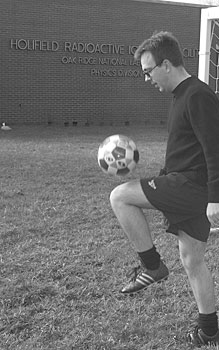 |
European by birth and nature, David Silvermyr practices his futbol skills on the field near his Physics Division office. |
David says that photons are the only particles not changed when they are knocked about in the quark-gluon plasma. The EMCal tracks the photons and determines their energy. From those data, along with studying data from the 13 other detectors, scientists will be able to reconstruct what happened during these particles’ lifetime span of 10-23 seconds and gain a better understanding of what particles were present at the beginning of the universe, a few microseconds after the Big Bang.
“This is basic science. We are trying to learn more about how the fundamental particles are constructed,” David says.
He says that none of this would be possible without funding, specifically the Lab Directed Research and Development grant that seeded David and Terry’s latest work.
“It really helped to get us going,” David says, “and could lead to work with ALICE for many years, since the experiment could run for about 15 years.”
David and Terry put together a proposal last March and the early grant allowed them to begin testing their module detectors at Brookhaven in November of 2005. The DOE reviewed the EMCal’s progress and, now, with the department’s support, David is preparing for his first trip back to Europe to do research.
“If I hadn’t applied to CERN the first time, I would be doing something else,” he says.
In less than a year, David Silvermyr will return to what he says is, “the biggest place, the world center for particle science” and also the place where he first witnessed the experimental world of quarks and gluons.—Ashley Yeager
Ashley Yeager and Charlie Smith (page 3) are summer interns from the University of Tennessee’s science writing program. ![]()
 Former pilot
Baba now flying high as medical
researcher
Former pilot
Baba now flying high as medical
researcher
How does an aviator go on to become a recipient of Science Spectrum magazine’s Most Promising Scientist award?
Ask Justin Baba. He has done it.
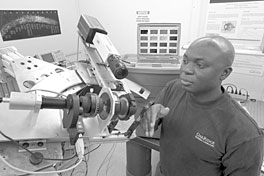 |
Justin Baba went from flying airplanes to doing research. “I love what I do now, he says. |
“As a kid, I wanted to be an aviator, to fly planes and see the world,” the biomedical engineer says.
Born in Nigeria, Justin came to the United States to pursue his dream of becoming a pilot. Justin obtained his undergraduate degree in aviation from LeTourneau University in Texas. Despite having professors tell him that he was wasting his scientific talent, Justin held fast to his dream to fly.
“I love to fly, but I hated it as a job,” he says. “You really just move people from one point to another.”
Once he had landed at the destination, Justin says he would just sit in the pilot’s lounge while waiting for the return flight. “There was a television, and so I would flip through the channels, but there is only so much to watch.”
Justin would always watch CNN headline news at 20-25 minutes after the hour. That was when they had their science and technology section, he says. “It would always come on with, ‘Scientists have discovered ...’, and I always thought I could be doing that instead of sitting here. I felt like I was doing nothing, when I could be trying to discover some new cure.”
Justin admits that he always enjoyed science and did exceedingly well in all his science classes. His teacher, in what is equivalent to the ninth grade in the British high school system, was the first to prod him to study science. Because he took a special interest in biology and understanding the human body and how it worked, his teacher suggested medicine.
“But my cousin was a surgeon and I just knew I didn’t want that kind of life. I didn’t want to promise my kids I would play with them and then not be able to because of work or an emergency,” he says. “Plus, I have always hated the smells in hospitals. My dream was to be an aviator, then.”
Justin worked for two years as a commercial airline pilot, “which is the ultimate in commercial aviation. You can impact the lives of maybe a handful of people for a short while,” he says. Watching TV and “wasting time,” got him to thinking about how fascinating it would be to do medical research.
“As a medical researcher I would have the opportunity to impact millions, maybe billions of people right now and maybe people for generations to come,” he says.
That led Justin to go back to school and pursue a degree in biomedical engineering. Seven years later he walked away from Texas A&M with his Ph.D. Justin immediately came to ORNL and joined the Engineering S&T Division in 2003 so he could further his research on a noninvasive skin cancer detection device. The early success of that research not only brought Justin media attention, but also aided his selection for the Science Spectrum award. The magazine will honor Justin at the Minorities in Research Science Awards Conference on Sept. 16.
“I was shocked to be selected. If you look at the list, it is the who’s who of science, so I was really shocked,” Justin says. “My boss thought I would win, but I didn’t think I would. We got everything together and sent it practically overnight. I was floored. I was and still am greatly honored by this award.”
The biomedical engineer is still working on the cancer detection research, along with other projects related to his background in using polarized light to do imaging. He works jointly with researchers at the UT Graduate School of Medicine to analyze mouse models’ suffering from amyloidosis, a protein-related disease, and Justin says this study has the potential to aid Alzheimer’s research and detection and development of medications.
“I love what I do now. I love it,” Justin says. “I can’t wait to get out of bed in the morning and get to work knowing that I may do something that has the potential to help so many people.”—Ashley Yeager ![]()
 Wellness programs: The next step in health management
Wellness programs: The next step in health management
| by KATHRYN COGAR |
On his way to the credit union on Main Street, Robert was met by an ocean of people, vendor exhibits and health screenings. It was the Benefits and Wellness Fair. He noticed a line of people waiting to have their blood sugar checked and he decided he might as well get checked while he was there.
Five minutes later, he had the results—not yet in the diabetic range but on the high end of normal.
“Wow!” he thought, “I wonder if I need to do something about this?”
Robert is an imaginary employee, but he is all too typical. He ranks as generally healthy but he is on a downward track toward disease and poor health unless he changes some key lifestyle behaviors. He may be aware of what he needs to do – or not. He may need some help in setting up and following through with a plan of action. Or he may be uninterested, unwilling or unable to do anything about it.
Employers across the nation are recognizing that they can play a key role helping employees improve or maintain healthy lifestyle habits and behaviors. A growing number of employers are providing health management and fitness programs to help employees increase their health awareness. The rationale is simple and straightforward: If Robert stays on the healthy side of the equation, he uses fewer health care dollars.
As health care costs continue to spiral upward, employers are searching for ways to reduce the trend. Employers are recognizing that improving the health of their organization is an important business strategy, and wellness programs are evolving to provide health improvement solutions.
At ORNL, a comprehensive wellness program is the next and possibly final step in realizing a fully integrated health management program. We’ve already made changes in the design of our health care plans, geared toward keeping the cost of health care affordable while maintaining a quality program of services. That’s one reason we have what might seem to be a complex maze of specialized providers—Matria, CIGNA, Medco, VSP, Aetna, Magellan, MetLife and Delta. Each vendor delivers health care services in its area of expertise. Thus Medco provides our pharmacy program, VSP delivers vision, MetLife and Delta provide dental, and CIGNA manages our overall medical plans.
The next stage has been to focus on identifying and targeting key, high-cost areas of health care for the Lab – disease and disability management. It comes as no surprise that those people who are the most ill use the most health care dollars, both in terms of total cost and frequency. Often, these are people who suffer from chronic diseases such as heart disease, diabetes, asthma or low back pain, or, are being treated for cancer. Disease management is a program of support to help these people become more knowledgeable and proactive in managing their health condition. The goal is to, at a minimum, stabilize their health condition and keep it from progressing, and ideally, to improve their health. Matria provides disease management through their Personal Health Assistance Program, which is available to all participants in our CIGNA plans at no additional cost to the employee.
Disability management (DM) focuses on time away from work for absences related to illness, injury or pregnancy. It’s important that you have the time you need to recover from an illness or injury. However, it’s a careful balance: Coming back to work too soon can result in complications or additional problems, but staying out too long makes it hard to get back “in the groove.” And, lost work time is expensive. Employees face reduced salaries for lengthy absences. For the company, lost time cannot be charged out to projects but must be absorbed internally, which impacts overhead and fringe rates. Obviously, it is in everyone’s best interest to get back to work as soon as is reasonable. Aetna (formerly Broadspire) has managed ORNL’s DM program since October 2003.
So, are these strategies working? With a multi-targeted approach, it’s hard to assign exclusive cause and effect. That said, we’ve seen a reduction in the cost of sick-related absences as a percent of total payroll since we implemented the DM program in 2003. And, as of July 1, 2006, our health care claims costs are trending below the national average (see sidebar).
This brings us back to wellness: With programs in place to help our highest-risk folks, it’s time to focus on supporting individuals to maintain their good health and avoid chronic conditions. Weight, nutrition, exercise, tobacco and alcohol use, and stress are all modifiable risk factors that have an effect on our health and well-being. Research at the University of Michigan has shown that the number of risk factors a person has dramatically impacts the cost of health care. In general, each of these risk factors adds an additional $2000 in claims cost yearly averaged over the life of the employee. By helping individuals reduce risk factors, wellness programs deliver cost savings through reduced health care costs over time.
Claims and cost – What’s the connection? What’s the connection between health care claims, cost and premiums? With auto and home insurance you pay a premium based on the value of your car or home and the insurance company pays any claims you may have. Our medical plan doesn’t work that way. The money that CIGNA uses to pay claims comes from the premiums that are paid by the company and employees. In other words, we, not the insurance company, cover the costs of our claims. So we have to collect enough in premiums to cover our claims costs each year. It stands to reason that if we can lower the cost of our claims, we reduce the amount of premium needed to cover our costs. Each year builds on the previous year’s experience, so 2007 premiums are set by looking at 2006 claims cost data. |
How do employer-sponsored wellness programs work? Vendors provide complete, self-contained programs that are a combination of Web-based and telephonic coaching services. The first step is for each participant to complete a Health Risk Assessment, a questionnaire designed to determine your risk factors and your level of interest or commitment to changing them. A screening to collect biometric information (height, weight, blood pressure, etc.) and lab data (cholesterol, glucose, triglycerides, etc.) can be part of the process as well. A personalized health report identifies risk factors and provides an action plan for improvement, supported by on-line tools and programs to help each participant set goals and stay on track. Programs are designed to give people the support they need to make lifestyle changes for the long term. It’s only by changing habits and behaviors that real change occurs.
These “turn-key” programs also integrate closely with an employer’s on-site wellness program. While personal information is strictly confidential, aggregate information can be used to guide on-site programming. This ensures that the specific needs of employees are being met.
Why would an employee participate? These programs are voluntary and offered at no cost. Secondly, many of us are genuinely interested in improving our health but need some help to get going.
Obviously, UT-Battelle is strongly interested in expanding our current Wellness Program so that it reaches and serves every UT-Battelle employee. Helping individuals maintain healthy lifestyles or eliminating the risks associated with their current behaviors will improve their overall level of health and productivity and contribute to a reduction in the cost of health care.
![]()
 ORICL Fall term features variety of classes
ORICL Fall term features variety of classes
It’s time for another year of interesting courses and educational trips at the Oak Ridge Institute for Continued Learning. ORICL has more than 550 members and is a non-credit educational program sponsored by Roane State Community College.
The low-cost, yearly ORICL membership is open to residents of Oak Ridge and the surrounding area of all backgrounds and educational levels. The no-exam courses are held at the RSCC Oak Ridge Branch Campus. ORICL is offering 57 classes and seven educational trips for the fall session which runs from September 18 through December 8. The early registration deadline is August 23.
ORICL members may choose from a large variety of courses in 13 areas including art & culture, computer, finance & economics, history, language, literature, medicine, music, philosophy, religion, science, social science, and miscellaneous. The fall trips include Biltmore Estate & Great Smoky Railroad, the Clarence Brown Theatre, Treasures of Ancient Egypt at the Frist Museum, Knoxville Zoo tour and lectures, Highlights of Kingston, Marble Springs/Ijams Nature Center, and the Miracle Theater.
Members of ORICL can sign up for up to five classes each term plus five trips. To attend classes and trips, membership in ORICL is necessary. The fee for membership is $90 for the full year’s three terms beginning in September; $70 for two terms (beginning in January); and $40 for the summer term only. To request a catalog or more information, call the ORICL office at 481-8222 or e-mail oricl@roanestate.edu. The ORICL website is at www.discoveret.org/oricl/.
 Truman Anderson, former planning director, dies
Truman Anderson, former planning director, dies
 |
Anderson |
Truman Anderson, former director of the Office of Planning and Management at ORNL, died July 29. He worked at the Lab for 36 years before retiring to his home in Kingston.
His achievements included a campaign in the 1990s to promote ORNL’s science message, which resulted in a series of award-winning special publications. Truman also sponsored the re-establishment of an ORNL employee newsletter, and his editorial vision endures in the Reporter. He was 74.
 New Staff
Members
New Staff
Members
James David Bowman, Physics
Cynthia Dianne Berry, Wei-Ren Chen, Ray Jack Ladd Frye, SNS Experimental Facilities Division
Jeremy Paul Price, SNS Accelerator Systems Division
Jeffrey D. Gorzynski and Amy Ruthann Brown, Human Resources
Udaya Chandrika Kalluri and Martin Keller, Environmental Sciences
Michael L. McIntosh, Safety Services
Weikuan Yu, Computer Science &
Mathematics
Sergio Mendez Dukes, Nonreactor Nuclear Facilities
Brett Daniel Ellis, Networking & Computing Technologies
Scott Thomas Retterer, Life Sciences
Division
Alice Arlene Reese-Seals, Gary Alan Bloom and Kathryn Parke Bugbee, Facilities Development
Keyona Danielle McCowan, Mark Patrick Wise, William Blake Housley, Debbie J. Robinson and Stephen Calvin Rose Jr., Craft Resources
Fulmer helps kick off campaign
 It’s United Way time at ORNL ... and in Tennessee
It’s United Way time at ORNL ... and in Tennessee
Hundreds of ORNL employees – many dressed in that distinctive shade of orange – gathered on Main Street in late July to hear UT head football coach Phillip Fulmer urge them to become “really, really involved in United Way,” as the Laboratory kicked off its 2006 campaign.
Sports metaphors abounded as the crowd heard remarks by Fulmer, ORNL Director Jeff Wadsworth and campaign chair Marilyn Brown and watched the final round of an employee putting contest, a fundraising feature of this year’s drive.
Harvey Gray won the contest, but Fulmer showed the best touch, holing his only attempt in an exhibition preceding the competition. He later told a TV reporter covering the event, “The precision of that shot should be a good omen for our upcoming season.”
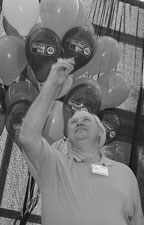 |
Vol football coach Phil Fulmer waves to the United Way campaign kickoff crowd after he sank his putt. |
In his kickoff remarks, the 14-year coach said the Vol football team’s theme this year is “fixed up, focused and prepared,” which could also be applied to the United Way drive. “I know you’ll do the same with your campaign, and I invite and encourage each of you to be a part of it and work very hard. It’s an important effort, and I’m honored to have a chance to be involved with United Way,” Fulmer said.
ORNL was the largest contributor to the United Way in the Tennessee Valley last year. The goal for this year’s drive, which runs through Sept. 30, is $800,000.
Other top finishers in the campaign’s putting contest, which was determined by distance from the hole, were Dennis Parton, Ed Blackburn, Mike Malozemoff, Mike Emery and Russ Smith.
Coach Fulmer also helped with a prize raffle and stayed after the ceremony to greet employees and sign memorabilia. Wadsworth and other Laboratory leaders later led him on a tour of new ORNL facilities.
Other events of this year’s campaign have included a book fair, United Way tours and an agency fair at the Laboratory. During the agency fair, employees had the opportunity to talk with representatives of nearly 20 area organizations receiving United Way funding.
“Another of our big events is the International Festival, scheduled for Wednesday,
Sept. 20,” Brown said. “It’s always very popular, and we expect it to be well-attended this year.” Food, music, dance, and great costumes are among the draws for the festival, which will be held on Main Street and the Quadrangle from 11 a.m. to 1 p.m.
Sales of the ORNL cookbook – 60 Years of Great Cooking – and the latest supplement also continue during the campaign. The cookbook, with the original 276 recipes, costs $12 ($10 if you buy two or more); the supplement (with an additional 250 recipes) is available for $8. Proceeds from all sales go toward the 2006 drive. To order, or for more information, contact Carol Leffew, leffewcj@ornl.gov or 574-5982. All checks should be made payable to United Way.
Members of this year’s ORNL United Way Cabinet are Chair, Marilyn Brown, with support from Laura Wagner; Co-chair, Karen Downer, with support from Cathy Cheverton; Payroll Stats, Mark Boatner; Graphics, Peggy Brown; Training, Stephanie Burke; ATLC Representative, Danny Cantrell; International Fair, Teresa Ferguson; Special Events, Bonnie Hebert; Treasurer, Tammy Hill; Special Events, Denny Jackson; General Support, Martha Justice; Special Events, Tom King; Agency Tours/Fundraising Support, Susie Kuliasha; Cookbooks, Carol Leffew; Book Fair, Barbara Littleton; Public Relations, Cindy Lundy; General Support, Wilson McGinn; Materials, Lisa Patt; Training, Carolyn Ward; 2005 Chair/Consultant, Lee Riedinger.
For additional information on United Way, go to home.ornl.gov/general/united_way/. —Cindy Lundy ![]()
Bill Cabage, editor, ORNL, 865/574-4399 (cabagewh@ornl.gov)
Deborah Barnes, associate editor, 865/576-0470 (barnesds@ornl.gov)
ORNL office: P.O. Box 2008, Oak Ridge, TN 37831-6146, Building 4500-N, Room K-238, MS 6266
News Deadlines
DOE inspector general hotline: 1-800-541-1625
[an error occurred while processing this directive] [an error occurred while processing this directive]
